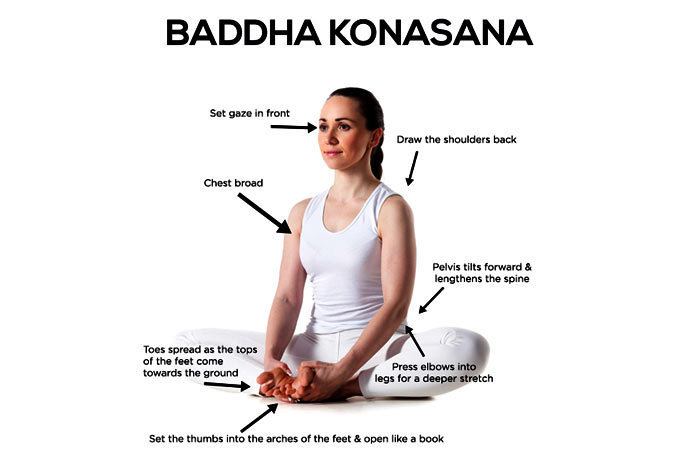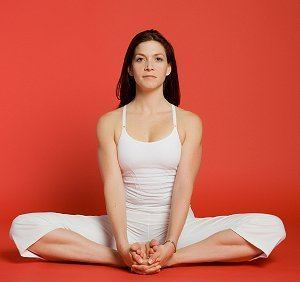Sanskrit बद्धकोणासन Meaning Bound Angle Posture Stretches Knee, Thigh, Groin | Devanagari बद्ध कोणासन Variations Supta Baddha Koṇāsana | |
 | ||
Effects summary Strengthens and improves flexibility in the inner thighs, groins and the kneesHelps prepare the hips and groins for meditative seated poses, which require more flexibility in these areasHelps to soothe menstrual discomfort and digestive complaintsStimulates the abdominal organs, potentially improving the health of the ovaries, prostate gland, kidneys and bladder.Alleviates fatigue, according to traditional yoga textsHelps open up the lower back and relieves sciaticaMetaphysically opens up the groin area helping to relieve sexual inhibitions and guilt. Note This asana should be avoided in case of Groin or knee injury. Be careful while bending if you suffer from High blood pressure or any cardiac problems. Baddha Konasana should be avoided by ladies if menstruating or should be performed under guidance of a yoga expert during those days. Consult a doctor before beginning an exercise regime Preparatory poses Vriksasana, Virasana, Supta Padangusthasana Pose type Forward bend, Seated, Hip opener Similar Supta Virasana, Uttanasana, Half Lord of the Fishes Pose ‑ Ar, Paschimottanasana, Trikonasana | ||
Baddha Konasana (BAH-dah koh-NAH-sah-nah; Sanskrit: बद्धकोणासन ; IAST: baddhakoṇāsana), Bound Angle Pose, or Cobbler Pose (after the typical sitting position of Indian cobblers when they work) is an asana.
Contents

Etymology
The name comes from the Sanskrit words baddha (बद्ध, baddha) meaning "bound", kona (कोण, koṇa) meaning "angle" or "split", and Asana (आसन, Āsana) meaning "posture" or "seat".
Description
From sitting position with both the legs outstretched forward, hands by the sides, palms resting on the ground, fingers together pointing forward, the legs are hinged at the knees so the soles of the feet meet. The legs are grasped at the ankles and folded more until the heels reach the perineum. The knees remain on the ground, the body erect and the gaze in front. The asana is held before coming back to the starting position. The thighs are stretched with care.
Benefits
It is a strong groin- and hip-opener and one of the few asanas that can be practiced comfortably soon after eating as long as the head is not rested on the floor. The asana is specially recommended for those suffering from urinary disorders. The pelvis, the abdomen and the back are stimulated by a plentiful blood supply.
It relieves sciatic pain and prevents hernia. If practised regularly, it relieves pain and heaviness in the testicles. For women, coupled with Sarvangasana, it checks irregular menses and helps the ovaries to function properly. Regular practise of this asana may be beneficial for the lumbar region, flat feet, high blood pressure, infertility and asthma.
Precautions
While doing the asana, take care that:
Variations
Supta Baddha Koṇāsana, Cobbler's Pose in Lying Position, supta (सुप्त) meaning "supine" or "reclining".
